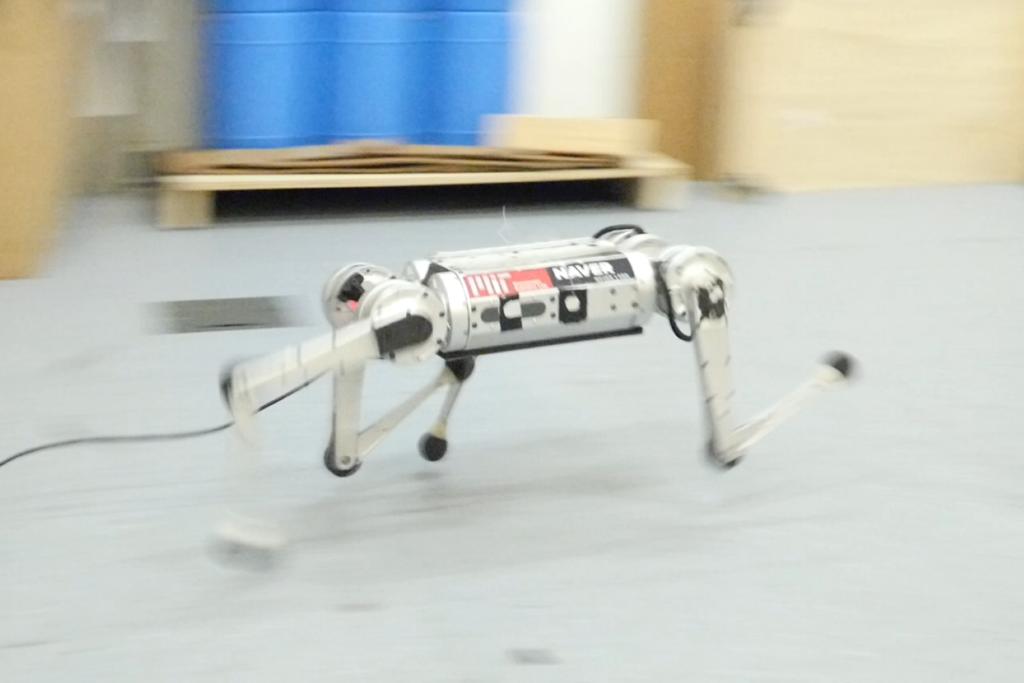Machine learning helped MIT’s cheetah robot break its own speed record
Thanks to artificial intelligence, the Mini Cheetah can go as fast as its hardware allows.
ByShi En Kim| Published Mar 18, 2022 2:00 PM
Mini Cheetah, the fastest robot of its build, poses with its lead AI researcher Gabriel Margolis and a friend's dog, Olive.MIT CSAILSHAREHorses gallop. Kangaroos hop. Ducks waddle. Elephants amble. The fleet-footed quadruped robot called Mini Cheetah… well, doesn’t move like anything in the animal kingdom. A cross between a scramble and a scamper, its gait is desperately chaotic and comically ungraceful. In fact, its particular style is dubbed “gait-free.” And this brandless bound is what makes it fast.
A team of researchers from the Massachusetts Institute of Technology (MIT) created a computer algorithm that spurs this artificially intelligent robot to maximize its speed, thereby breaking its own sprint records. In several demonstrations, Mini Cheetah can still go turbo as it spins in a circle or darts across ice, loose gravel, and inclines.
“What we are interested in is, given the robotic hardware, how fast can [a robot] go?” says Pulkit Agrawal, an AI researcher at MIT and the leader of the Improbable AI Lab that conceived the project. “We didn’t want to constrain the robot in arbitrary ways.”
Previous top robot runners were only speedy in limited scenarios. They performed best on an indoor treadmill, but suffered when navigating uneven terrains in the real world. Conversely, robots that could cross any kind of topography were generally sluggish across the board, because they weren’t optimized for speed; their responses were challenging to program. Mini Cheetah has the best of both worlds. (But perhaps, just not elegance.)

Traditionally, programming a swift robot requires engineers to pre-emptively work out all the possible variables in the environment that could be a drag, such as friction. Then, they would have to wire in all the commands for every possible rundown and analyze the errors the robot made afterwards. This process involves the robot running many real-world trials, because engineers can’t account for all unknowns in all settings beforehand.
The MIT researchers’ workaround was to use reinforcement learning, a goal-driven form of machine learning, to help a robot like Mini Cheetah figure out how to reach its top speed on its own. First, the team simulated all the potential scenarios of the real-world in a computer. Then they trained Mini Cheetah’s software on these virtual simulations before its deployment. Schooled on this dataset and free of any programming constraints, Mini Cheetah is able to create its own signature sprinting style that humans wouldn’t have been able to conceive of. (This may explain why its movements look quite unnatural to us.) Furthermore, it could modify how it loped in real time to adapt to the conditions of its route.
Thanks to this machine learning software, Mini Cheetah bumped its peak indoor velocity from 12 feet per second before training to 13 feet per second after. It more or less maintained this speed outdoors when tearing up unfamiliar grounds. It could catch itself when it tripped. Even if it had a broken leg, it could find a way to hobble on at maximum speed.
Agrawal says that hardware upgrades will be necessary for Mini Cheetah to go even faster. For example, its engineers can give it a more powerful motor or even include an ankle-equivalent joint in each of its limbs, which can in theory bump up its speed even more. Other hardware enhancements that can boost Mini Cheetah’s agility and responsiveness include incorporating sensory elements such as vision, so the robot can literally look before it leaps and switch up its running behavior in advance when it spots a rough patch ahead. This may allow Mini Cheetah to stay swift on challenging terrains.
To be clear, the team isn’t gunning for the world’s fastest automaton. Instead, the researchers aim to democratize sprinting for any run-of-the-mill robot.
“The cool thing is that you could apply this algorithm to any robot, and it could also very likely maximize the speed on that robotic platform,” says Agrawal, “because we’re not making any specific assumptions about that robot.”
The researchers plan to make their computer code open source by early next week. Then, every robot may be able to reach its full running potential—only the hardware is the limit.
Watch the video of Mini Cheetah run here:
Shi En KimShi En Kim (she usually goes by Kim) is a Malaysian-born freelance science writer and a Popular Science's spring 2022 editorial intern. She writes broadly about different topics, from the wacky uses of spider webs—by both humans or spiders themselves—to garbage collectors in outer space.
artificial intelligence robotics Science Technology







